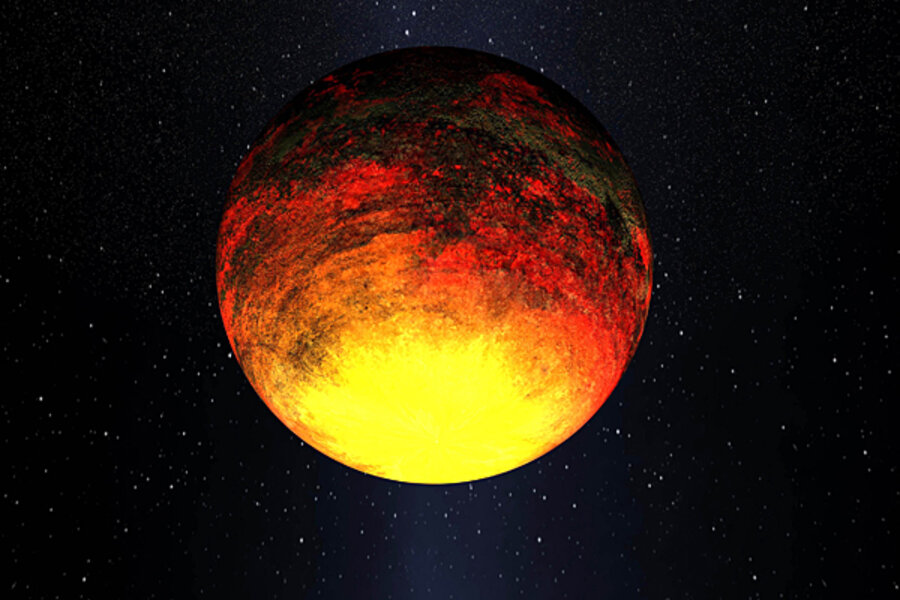In search for Earth-size world, a historic first: Kepler finds rocky planet
Loading...
A team of astronomers has made what it says is the first unambiguous discovery of an Earth-size rocky planet orbiting a distant star – one 560 light-years from Earth. It is the smallest planet discovered to date, the team says.
Don't look for life there. The planet is orbiting so close to its host star that the surface temperature on the star-lit portion of the planet is more than 2,500 degrees Fahrenheit, hot enough to melt iron, the team estimates.
But it's plausible that the planet could have canyons carved by rivers of molten material on its torrid surface, says one team member.
The discovery, made with NASA's Kepler planet-hunting spacecraft and announced Jan. 10, "will be marked as among the most profound scientific discoveries in human history," says Geoffrey Marcy, an accomplished planet-hunter at the University of California at Berkeley who was not part of the discovery team.
Much as anthropologists have uncovered so-called missing links along the multimillion-year history of human evolution, Dr. Marcy says, this discovery provides a missing link between gas-giant planets that have dominated extrasolar-planet discoveries so far, and the much-sought Earth-size planets capable of hosting life.
Other scientists are a bit more cautious, noting that the new planet may in fact be the rocky core of a close-in gas giant whose gas has boiled away over the star's 8-billion-year life so far.
No atmosphere and a tail of iron fragments?
Still, for a mission designed to hunt for Earth-mass planets at Earth-like distances around far-away suns, Monday's announcement represents a milestone for the Kepler team and for humanity, says Kepler team member Natalie Batahla, an astronomer at San Jose State University.
The planet, known as Kepler 10b, has 1.4 times Earth's radius and tips the scale at some 4.6 times Earth's mass. That gives it a density significantly higher than any of the inner planets in our solar system. Indeed, its density lies somewhere between that of bulk iron and copper.
It orbits its host star once every 20 hours and 10 minutes. That puts it some 20 times closer to its star than Mercury, our solar system's innermost planet, is to the sun. The team estimates that the planet's gravity is about twice as strong as Earth's.
In announcing the discovery on behalf of the Kepler team, Dr. Batahla noted that the planet has no atmosphere, but given the searing temperatures on the sunlight side, the planet could well be trailing behind it a comet-like tail of tiny fragments made of iron and silicate minerals.
With its strong gravitational field, she says it's unlikely the planet has mountains. But Batahla did posit the possibility of canyons and rivers of molten material.
How Kepler works
Kepler, launched in March 2009, is designed to hunt for Earth-mass extrasolar planets that eclipse their suns, if only faintly. The spacecraft, in an Earth-trailing orbit around the sun, is designed to measure with exquisite precision the light coming from some 150,000 stars in a region between the constellation Cygnus and Lyra. It's staring at these stars simultaneously, with an initial mission lifetime of 3-1/2 years.
By measuring the slight dimming the starlight undergoes when a planet passes in front of it, astronomers can calculate the planet's size. When the sighting is confirmed using a complementary technique, which measures the slight wobble the planet imparts to the star as it orbits, researchers can estimate the planet's mass. Using both measures, they can derive the planet's density and hence make inferences about its composition.
During a press briefing at the winter meeting of the American Astronomical Society in Seattle, where the announcement about Kepler 10b was made, Batahla hinted that similar announcements could come early next month.
Last June the team published a catalog of 306 stars, "all with planet candidates," she said. "The majority of them are smaller than Neptune."
More refined measurements of these will come with the release of the new catalog, she suggested.





